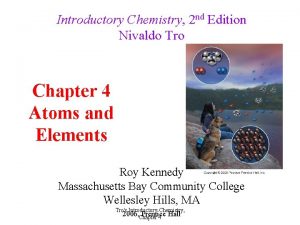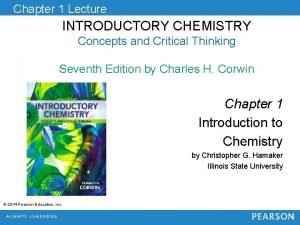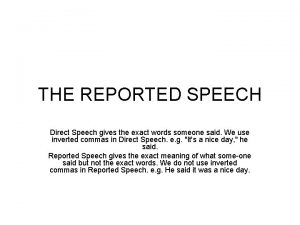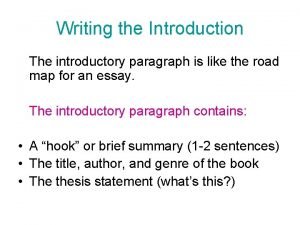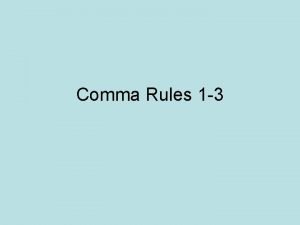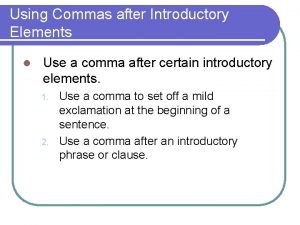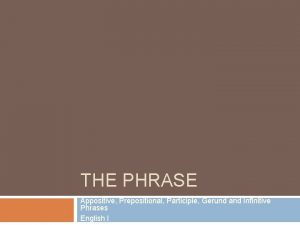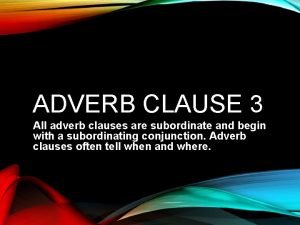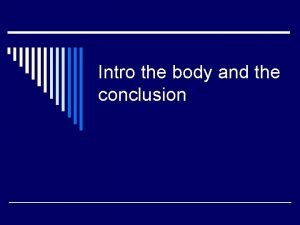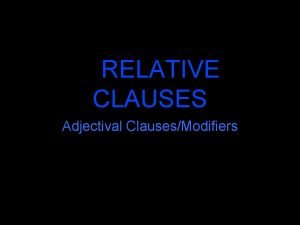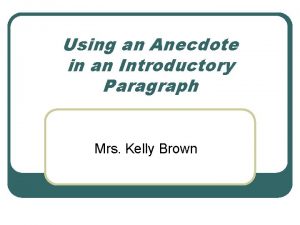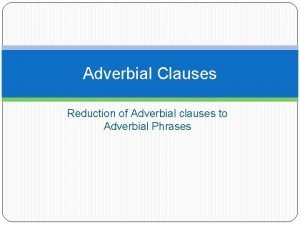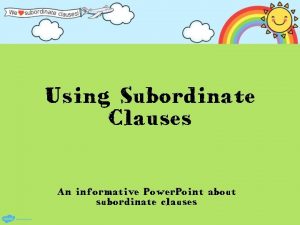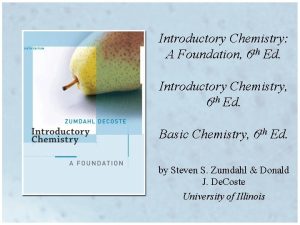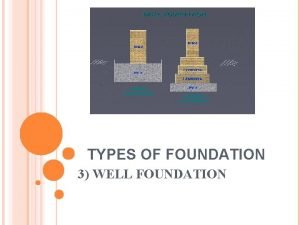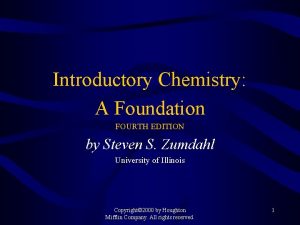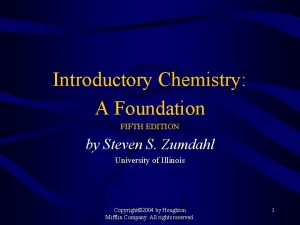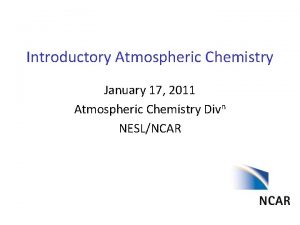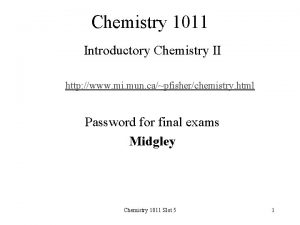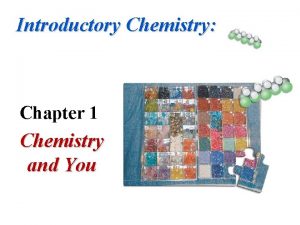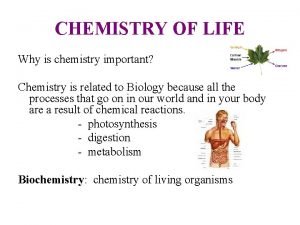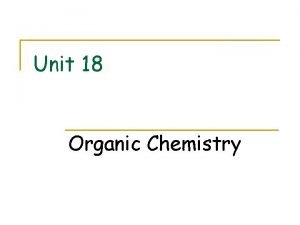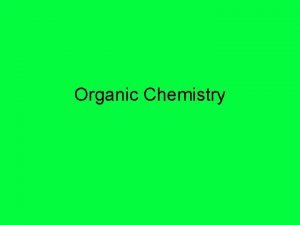Introductory Chemistry A Foundation 6 th Ed Introductory


























![Acidic and Basic Solutions • Acidic solutions have a larger [H+] than [OH-] • Acidic and Basic Solutions • Acidic solutions have a larger [H+] than [OH-] •](https://slidetodoc.com/presentation_image_h2/74c22ddbcb8538e6bd29e947a2c22fe5/image-27.jpg)

![Example #2 Determine the [H+] and [OH-] in a 10. 0 M H+ solution Example #2 Determine the [H+] and [OH-] in a 10. 0 M H+ solution](https://slidetodoc.com/presentation_image_h2/74c22ddbcb8538e6bd29e947a2c22fe5/image-29.jpg)

![Example #2 (cont. ) Given [H+] = 10. 0 M = 1. 00 x Example #2 (cont. ) Given [H+] = 10. 0 M = 1. 00 x](https://slidetodoc.com/presentation_image_h2/74c22ddbcb8538e6bd29e947a2c22fe5/image-31.jpg)
![Self check p 497 • Calculate [H+] in a solution in which [OH-] = Self check p 497 • Calculate [H+] in a solution in which [OH-] =](https://slidetodoc.com/presentation_image_h2/74c22ddbcb8538e6bd29e947a2c22fe5/image-32.jpg)




![Example #3 Calculate the p. H of a solution with a [OH-] = 1. Example #3 Calculate the p. H of a solution with a [OH-] = 1.](https://slidetodoc.com/presentation_image_h2/74c22ddbcb8538e6bd29e947a2c22fe5/image-37.jpg)
![Example #3 (cont. ) • Find the concentration of [H+] Copyright © Houghton Mifflin Example #3 (cont. ) • Find the concentration of [H+] Copyright © Houghton Mifflin](https://slidetodoc.com/presentation_image_h2/74c22ddbcb8538e6bd29e947a2c22fe5/image-38.jpg)
![Example #3 (cont. ) • Enter the [H+] concentration into your calculator and press Example #3 (cont. ) • Enter the [H+] concentration into your calculator and press](https://slidetodoc.com/presentation_image_h2/74c22ddbcb8538e6bd29e947a2c22fe5/image-39.jpg)

![Solving concentration from p. H or p. OH Calculate the [OH-] of a solution Solving concentration from p. H or p. OH Calculate the [OH-] of a solution](https://slidetodoc.com/presentation_image_h2/74c22ddbcb8538e6bd29e947a2c22fe5/image-41.jpg)




![Example #6 (cont. ) • Determine the [H+] from the acid concentration HNO 3 Example #6 (cont. ) • Determine the [H+] from the acid concentration HNO 3](https://slidetodoc.com/presentation_image_h2/74c22ddbcb8538e6bd29e947a2c22fe5/image-46.jpg)




- Slides: 50

Introductory Chemistry: A Foundation, 6 th Ed. Introductory Chemistry, 6 th Ed. Basic Chemistry, 6 th Ed. by Steven S. Zumdahl & Donald J. De. Coste University of Illinois

Chapter 16 Acids and Bases



Properties of Acids • • Sour taste Turn blue litmus paper red Change color of vegetable dyes (red cabbage juice) React with “active” metals – Like Al, Zn, Fe, but not Cu, Ag or Au Zn + 2 HCl Zn. Cl 2 + H 2 • Corrosive • React with carbonates, producing CO 2 – Marble, baking soda, chalk Ca. CO 3 + 2 HCl Ca. Cl 2 + CO 2 + H 2 O • React with bases to form ionic salts, and often water Copyright © Houghton Mifflin Company. All rights reserved. 16 | 5

Properties of Bases • • Also known as alkalis Bitter Taste Feel slippery Change color of vegetable dyes – Different color than acid – Turn red litmus blue • React with acids to form ionic salts, and often water – Neutralization Copyright © Houghton Mifflin Company. All rights reserved. 16 | 6

Arrhenius Theory • Acids ionize in water to H+ ions and anions • Bases ionize in water to OH- ions and cations • Neutralization reaction involves H+ combining with OH- to make water • H+ ions are protons Copyright © Houghton Mifflin Company. All rights reserved. 16 | 7

Arrhenius Theory (cont. ) • Definition only good in water solution • Definition does not explain why ammonia solutions turn litmus blue – Basic without OH- ions Copyright © Houghton Mifflin Company. All rights reserved. 16 | 8

Brønsted-Lowry Theory • H+ transfer reaction – Since H+ is a proton, also known as proton transfer reactions Acids are proton donors, bases are proton acceptors • In the reaction, a proton from the acid molecule is transferred to the base molecule • Products are called the conjugate acid and conjugate base Copyright © Houghton Mifflin Company. All rights reserved. 16 | 9

Brønsted-Lowry Theory (cont. ) Copyright © Houghton Mifflin Company. All rights reserved. 16 | 10

Brønsted-Lowry Theory (cont. ) H-A + : B A- + H-B+ A- is the conjugate base, H-B+ is the conjugate acid • Conjugate acid-base pair is either the original acid and its conjugate base or the original base and its conjugate acid – H-A and A- are a conjugate acid-base pair – : B and H-B+ are a conjugate acid-base pair Copyright © Houghton Mifflin Company. All rights reserved. 16 | 11

Example #1: Write the conjugate base for the acid H 3 PO 4 • Determine what species you will get if you remove 1 H+1 from the acid. – Conjugate base will have one more negative charge than the original acid H 3 PO 4 H+ + H 2 PO 4 - Copyright © Houghton Mifflin Company. All rights reserved. 16 | 12

Self- check p 490 • Which of the following represent conjugate acid base pairs? • A. H 2 O, H 3 O+ • B. OH-, HNO 3 • C. H 2 SO 4, SO 42 • D. HC 2 H 3 O 2, C 2 H 3 O 2 - Copyright © Houghton Mifflin Company. All rights reserved. 16 | 13

Brønsted-Lowery Theory (cont. ) • In this theory, instead of the acid, HA, dissociating into H+(aq) and A- (aq), the acid donates its H to a water molecule HA + H 2 O A- + H 3 O+ A-1 is the conjugate base, H 3 O+ is the conjugate acid Copyright © Houghton Mifflin Company. All rights reserved. 16 | 14

Brønsted-Lowry Theory (cont. ) • H 3 O+ is called the hydronium ion • In this theory, substances that do not have OH- ions can act as a base if they can accept a H+1 from water. H 2 O + : B OH- + H-B+ : B is acting here as a base. Copyright © Houghton Mifflin Company. All rights reserved. 16 | 15

Strength of Acids & Bases • The stronger the acid, the more willing it is to donate H+ Copyright © Houghton Mifflin Company. All rights reserved. 16 | 16

Strength of Acids & Bases (cont. ) • Strong bases will react completely with water to form hydroxide: CO 3 -2 + H 2 O HCO 3 - + OH • Only small fraction of weak base molecules pull H+ off water: HCO 3 - + H 2 O H 2 CO 3 + OH- Copyright © Houghton Mifflin Company. All rights reserved. 16 | 17

Multiprotic Acids • Monoprotic acids have 1 acid H, diprotic 2, etc. – In oxyacids only the H on the O is acidic • In strong multiprotic acids, like H 2 SO 4, only the first H is strong; transferring the second H is usually weak H 2 SO 4 + H 2 O H 3 O+ + HSO 4 - + H 2 O H 3 O+ + SO 4 -2 Copyright © Houghton Mifflin Company. All rights reserved. 16 | 18

Water As an Acid and a Base • Amphoteric substances can act as either an acid or a base. – Water as an acid, NH 3 + H 2 O NH 4+ + OH– Water as a base, HCl + H 2 O H 3 O+ + Cl- • Water can even react with itself: H 2 O + H 2 O H 3 O + + OH- Copyright © Houghton Mifflin Company. All rights reserved. 16 | 19

Autoionization of Water • Water is an extremely weak electrolyte. – Therefore there must be a few ions present H 2 O + H 2 O H 3 O+ + OH- Copyright © Houghton Mifflin Company. All rights reserved. 16 | 20

Acid Nomenclature • Acids – Compounds that form H+ in water. – Formulas usually begin with ‘H’. – In order to be an acid instead of a gas, binary acids must be aqueous (dissolved in water) – Ternary acids are ALL aqueous • Examples: – HCl (aq) – hydrochloric acid – HNO 3 – nitric acid – H 2 SO 4 – sulfuric acid Copyright © Houghton Mifflin Company. All rights reserved. 16 | 21

Acid nomenclature • If anion ending is –ide (Binary compound), the acid name is hydro(stem)ic acid • If ternary compounds • -Ate ending: (stem)ic acid • -ite ending: (stem)ous acid Copyright © Houghton Mifflin Company. All rights reserved. 16 | 22

Acid Nomenclature Flowchart Copyright © Houghton Mifflin Company. All rights reserved. 16 | 23

Solved examples • • • HBr – 2 elements-ide, hydrobromic acid H 2 CO 3 - 3 elements- ate, carbonic acid H 2 SO 3 - 3 elements- ite, sulfurous acid Hydrofluoric acid: 2 elements= HF Sulfuric acid: 3 elements, –ic= -ate, H 2 SO 4 Nitrous acid: 3 elements, -ous= -ite, HNO 2 Copyright © Houghton Mifflin Company. All rights reserved. 16 | 24

Now your turn! • HI (aq) • HCl • H 2 SO 3 • HNO 3 • HIO 4 Copyright © Houghton Mifflin Company. All rights reserved. 16 | 25

• Hydrobromic acid • Nitrous acid • Carbonic acid • Phosphoric acid Copyright © Houghton Mifflin Company. All rights reserved. 16 | 26
![Acidic and Basic Solutions Acidic solutions have a larger H than OH Acidic and Basic Solutions • Acidic solutions have a larger [H+] than [OH-] •](https://slidetodoc.com/presentation_image_h2/74c22ddbcb8538e6bd29e947a2c22fe5/image-27.jpg)
Acidic and Basic Solutions • Acidic solutions have a larger [H+] than [OH-] • Basic solutions have a larger [OH-] than [H+] • Neutral solutions have [H+]=[OH-]= 1 x 10 -7 M [H+] = 1 x 10 -14 [OH-] Copyright © Houghton Mifflin Company. All rights reserved. [OH-] -14 1 x 10 = [H+] 16 | 27

Ion product of water Copyright © Houghton Mifflin Company. All rights reserved. 16 | 28
![Example 2 Determine the H and OH in a 10 0 M H solution Example #2 Determine the [H+] and [OH-] in a 10. 0 M H+ solution](https://slidetodoc.com/presentation_image_h2/74c22ddbcb8538e6bd29e947a2c22fe5/image-29.jpg)
Example #2 Determine the [H+] and [OH-] in a 10. 0 M H+ solution Copyright © Houghton Mifflin Company. All rights reserved. 16 | 29

Example #2 (cont. ) • Determine the given information and the information you need to find – Given [H+] = 10. 0 M, find [OH-] Copyright © Houghton Mifflin Company. All rights reserved. 16 | 30
![Example 2 cont Given H 10 0 M 1 00 x Example #2 (cont. ) Given [H+] = 10. 0 M = 1. 00 x](https://slidetodoc.com/presentation_image_h2/74c22ddbcb8538e6bd29e947a2c22fe5/image-31.jpg)
Example #2 (cont. ) Given [H+] = 10. 0 M = 1. 00 x 101 M Kw = 1. 0 x 10 -14 Copyright © Houghton Mifflin Company. All rights reserved. 16 | 31
![Self check p 497 Calculate H in a solution in which OH Self check p 497 • Calculate [H+] in a solution in which [OH-] =](https://slidetodoc.com/presentation_image_h2/74c22ddbcb8538e6bd29e947a2c22fe5/image-32.jpg)
Self check p 497 • Calculate [H+] in a solution in which [OH-] = • 2. 0 X 10 -2 M. Is this solution acidic, neutral or basic? Copyright © Houghton Mifflin Company. All rights reserved. 16 | 32

p. H & p. OH • The acidity/basicity of a solution is often expressed as p. H or p. OH. • p. H = -log[H 3 O+] p. OH = -log[OH-] – p. Hwater = -log[10 -7] = 7 = p. OHwater • [H+] = 10 -p. H [OH-] = 10 -p. OH Copyright © Houghton Mifflin Company. All rights reserved. 16 | 33

p. H scales Copyright © Houghton Mifflin Company. All rights reserved. 16 | 34

p. H & p. OH (cont. ) • p. H < 7 is acidic; p. H > 7 is basic, p. H = 7 is neutral • The lower the p. H, the more acidic the solution; the higher the p. H, the more basic the solution • 1 p. H unit corresponds to a factor of 10 difference in acidity • p. OH = 14 - p. H Copyright © Houghton Mifflin Company. All rights reserved. 16 | 35

p. H of Common Substances Copyright © Houghton Mifflin Company. All rights reserved. 16 | 36
![Example 3 Calculate the p H of a solution with a OH 1 Example #3 Calculate the p. H of a solution with a [OH-] = 1.](https://slidetodoc.com/presentation_image_h2/74c22ddbcb8538e6bd29e947a2c22fe5/image-37.jpg)
Example #3 Calculate the p. H of a solution with a [OH-] = 1. 0 x 10 -6 M Copyright © Houghton Mifflin Company. All rights reserved. 16 | 37
![Example 3 cont Find the concentration of H Copyright Houghton Mifflin Example #3 (cont. ) • Find the concentration of [H+] Copyright © Houghton Mifflin](https://slidetodoc.com/presentation_image_h2/74c22ddbcb8538e6bd29e947a2c22fe5/image-38.jpg)
Example #3 (cont. ) • Find the concentration of [H+] Copyright © Houghton Mifflin Company. All rights reserved. 16 | 38
![Example 3 cont Enter the H concentration into your calculator and press Example #3 (cont. ) • Enter the [H+] concentration into your calculator and press](https://slidetodoc.com/presentation_image_h2/74c22ddbcb8538e6bd29e947a2c22fe5/image-39.jpg)
Example #3 (cont. ) • Enter the [H+] concentration into your calculator and press the log key – log(1. 0 x 10 -8) = -8. 0 • Change the sign to get the p. H – p. H = -(-8. 0) = 8. 0 Copyright © Houghton Mifflin Company. All rights reserved. 16 | 39

Example #4 Calculate the p. H and p. OH of a solution with a [OH-] = 1. 0 x 10 -3 M • Enter the [H+] or [OH-] concentration into your calculator and press the log key log(1. 0 x 10 -3) = -3. 0 • Change the sign to get the p. OH = -(-3) = 3. 0 • Subtract the calculated p. H or p. OH from 14. 00 to get the other value p. H = 14. 00 – 3. 0 = 11. 0 Copyright © Houghton Mifflin Company. All rights reserved. 16 | 40
![Solving concentration from p H or p OH Calculate the OH of a solution Solving concentration from p. H or p. OH Calculate the [OH-] of a solution](https://slidetodoc.com/presentation_image_h2/74c22ddbcb8538e6bd29e947a2c22fe5/image-41.jpg)
Solving concentration from p. H or p. OH Calculate the [OH-] of a solution with a p. H of 7. 41 • If you want to calculate [OH-] use p. OH; if you want [H+] use p. H. It may be necessary to convert one to the other using 14 = [H+] + [OH-] p. OH = 14. 00 – 7. 41 = 6. 59 Copyright © Houghton Mifflin Company. All rights reserved. 16 | 41

Example #5 (cont. ) • Enter the p. H or p. OH concentration into your calculator • Change the sign of the p. H or p. OH -p. OH = -(6. 59) • Press the button(s) on you calculator to take the inverse log or 10 x [OH-] = 10 -6. 59 = 2. 6 x 10 -7 M Copyright © Houghton Mifflin Company. All rights reserved. 16 | 42

Self check p 499 • Calculate the p. H value for each of the following solutions at 25°C. • A. a solution in which [H+] =1. 0 X 10 -9 M. • B. a solution in which [OH-] =1. 0 X 10 -6 M. • P 501 - A sample of rain in an area with severe air pollution has a p. H of 3. 5. What is the p. OH of this rainwater? Copyright © Houghton Mifflin Company. All rights reserved. 16 | 43

Calculating the p. H of a Strong, Monoprotic Acid • A strong acid will dissociate 100% HA H+ + A • Therefore the molarity of H+ ions will be the same as the molarity of the acid • Once the H+ molarity is determined, the p. H can be determined p. H = -log[H+] Copyright © Houghton Mifflin Company. All rights reserved. 16 | 44

Example #6 Calculate the p. H of a 0. 10 M HNO 3 solution. Copyright © Houghton Mifflin Company. All rights reserved. 16 | 45
![Example 6 cont Determine the H from the acid concentration HNO 3 Example #6 (cont. ) • Determine the [H+] from the acid concentration HNO 3](https://slidetodoc.com/presentation_image_h2/74c22ddbcb8538e6bd29e947a2c22fe5/image-46.jpg)
Example #6 (cont. ) • Determine the [H+] from the acid concentration HNO 3 H+ + NO 30. 10 M HNO 3 = 0. 10 M H+ • Enter the [H+] concentration into your calculator and press the log key log(0. 10) = -1. 00 • Change the sign to get the p. H = -(-1. 00) = 1. 00 Copyright © Houghton Mifflin Company. All rights reserved. 16 | 46

Self check p 503 • The p. H of rainwater in a polluted area was measured to be 3. 5. What is the [H+] in this rainwater? • The p. OH of a liquid drain cleaner was found to be 10. 50. What is the [OH-] for this cleaner? • P 505 - Calculate the p. H of a solution of 5. 0 X 10 -3 M HCl. Copyright © Houghton Mifflin Company. All rights reserved. 16 | 47

Buffered Solutions • Buffered solutions resist change in p. H when an acid or base is added to it. • Used when need to maintain a certain p. H in the system – Blood Copyright © Houghton Mifflin Company. All rights reserved. 16 | 48

Buffered Solutions (cont. ) • A buffer solution contains a weak acid and its conjugate base. • Buffers work by reacting with added H+ or OHions so they do not accumulate and change the p. H. • Buffers will only work as long as there are sufficient weak acid and conjugate base molecules present. Copyright © Houghton Mifflin Company. All rights reserved. 16 | 49

Buffered Solutions (cont. ) Copyright © Houghton Mifflin Company. All rights reserved. 16 | 50
 Introductory chemistry 5th edition nivaldo j. tro
Introductory chemistry 5th edition nivaldo j. tro Nivaldo j. tro introductory chemistry
Nivaldo j. tro introductory chemistry Introductory chemistry 4th edition
Introductory chemistry 4th edition Introductory chemistry concepts and critical thinking
Introductory chemistry concepts and critical thinking Prefix multipliers
Prefix multipliers Composition of urine
Composition of urine Pad foundation
Pad foundation Ib organic chemistry functional groups
Ib organic chemistry functional groups Inorganic vs organic chemistry
Inorganic vs organic chemistry Atlas ti 7
Atlas ti 7 Introduction paragraph outline
Introduction paragraph outline Advise reported speech
Advise reported speech Activity 1 introductory activity
Activity 1 introductory activity Introductory rite
Introductory rite Conclusion paragraph format
Conclusion paragraph format Introductory paragraph examples
Introductory paragraph examples Core focus on introductory algebra
Core focus on introductory algebra Introductory maxqda course
Introductory maxqda course Conclusion examples
Conclusion examples Army traffic safety introductory course
Army traffic safety introductory course Introductory slide
Introductory slide Introductory elements examples
Introductory elements examples Comma after introductory prepositional phrase
Comma after introductory prepositional phrase Circle kicker journalism
Circle kicker journalism Comma after introductory phrase
Comma after introductory phrase Introductory material
Introductory material Numerical
Numerical How much does it cost indirect question
How much does it cost indirect question Introductory paragraph format
Introductory paragraph format Gerund
Gerund Introductory performance review
Introductory performance review Bold pronouncement hook
Bold pronouncement hook Must not sentences examples
Must not sentences examples Introductory adverb clause
Introductory adverb clause Exodus 12:2
Exodus 12:2 Introductory video
Introductory video Model introduction paragraph
Model introduction paragraph Paragraph about desert
Paragraph about desert Intro body conclusion
Intro body conclusion Whats an introductory paragraph
Whats an introductory paragraph Introductory rites clipart
Introductory rites clipart Good introduction paragraph examples
Good introduction paragraph examples Introduction paragraph examples high school
Introduction paragraph examples high school Relative pronouns
Relative pronouns Anecdote
Anecdote What is adverbial clause
What is adverbial clause Main clause
Main clause Introductory adverbial clause examples
Introductory adverbial clause examples Nature of econometrics
Nature of econometrics Example of paragraph
Example of paragraph The canterbury tales setting
The canterbury tales setting

